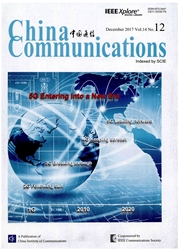

 中文摘要:
中文摘要:
In this paper,an energy-harvesting cognitive radio(CR) is considered,which allows the transmitter of the secondary user(SU) to harvest the primary signal energy from the transmitter of the primary user(PU) when the presence of the PU is detected.Then the harvested energy is converted into the electrical power to supply the transmission of the SU at the detected absence of the PU.By adopting the periodic spectrum sensing,the average total transmission rate of the SU is maximized through optimizing the sensing time,subject to the constraints of the probabilities of false alarm and detection,the harvested energy and the interference rate control.The simulation results show that there deed exists an optimal sensing time that maximizes the transmission rate,and the maximum transmission rate of the energy-harvesting CR can better approach to that of the traditional CR with the increasing of the detection probability.更多还原
 英文摘要:
英文摘要:
In this paper,an energy-harvesting cognitive radio(CR) is considered,which allows the transmitter of the secondary user(SU) to harvest the primary signal energy from the transmitter of the primary user(PU) when the presence of the PU is detected.Then the harvested energy is converted into the electrical power to supply the transmission of the SU at the detected absence of the PU.By adopting the periodic spectrum sensing,the average total transmission rate of the SU is maximized through optimizing the sensing time,subject to the constraints of the probabilities of false alarm and detection,the harvested energy and the interference rate control.The simulation results show that there deed exists an optimal sensing time that maximizes the transmission rate,and the maximum transmission rate of the energy-harvesting CR can better approach to that of the traditional CR with the increasing of the detection probability.
 同期刊论文项目
同期刊论文项目
 同项目期刊论文
同项目期刊论文
 Game Theoretic Analysis for Pricing-based Incentive Mechanism in Non-dedicated Cooperative Relay Net
Game Theoretic Analysis for Pricing-based Incentive Mechanism in Non-dedicated Cooperative Relay Net Joint Optimal Sensing Threshold and Subcarrier Power Allocation in Wideband Cognitive Radio for Mini
Joint Optimal Sensing Threshold and Subcarrier Power Allocation in Wideband Cognitive Radio for Mini Uniqueness and Asymptotic Behavior of Positive Solutions for a Fractional-Order Integral Boundary Va
Uniqueness and Asymptotic Behavior of Positive Solutions for a Fractional-Order Integral Boundary Va Joint cooperative spectrum sensing and channel selection optimization for satellite communication sy
Joint cooperative spectrum sensing and channel selection optimization for satellite communication sy An Improving Energy Efficiency Cooperation Algorithm Based on Nash Bargaining Solution in Selfish Us
An Improving Energy Efficiency Cooperation Algorithm Based on Nash Bargaining Solution in Selfish Us A Simplified Multiband Sampling and Detection Method Based on MWC Structure for Mm-wave Communicatio
A Simplified Multiband Sampling and Detection Method Based on MWC Structure for Mm-wave Communicatio Optimal Spectrum Sensing and Transmission Power Allocation in Energy-efficiency Multichannel Cogniti
Optimal Spectrum Sensing and Transmission Power Allocation in Energy-efficiency Multichannel Cogniti Optimal Simultaneous Cooperative Spectrum Sensing and Wireless Power Transfer with Power Splitting i
Optimal Simultaneous Cooperative Spectrum Sensing and Wireless Power Transfer with Power Splitting i Resource Allocation Algorithm Based on Bandwidth Demands for OFDMA Systems with Imperfect Channel Qu
Resource Allocation Algorithm Based on Bandwidth Demands for OFDMA Systems with Imperfect Channel Qu Channel Estimation Algorithm Based on Compressive Sensing for NC-OFDM Systems in Cognitive Radio Con
Channel Estimation Algorithm Based on Compressive Sensing for NC-OFDM Systems in Cognitive Radio Con 期刊信息
期刊信息
